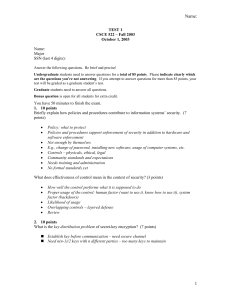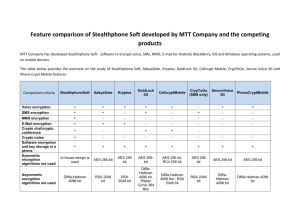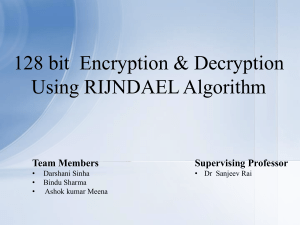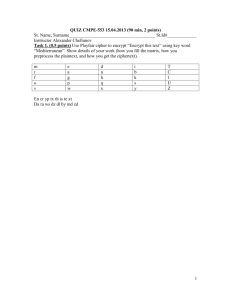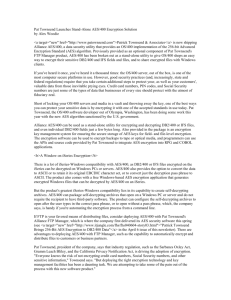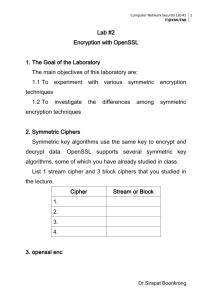Homework
advertisement
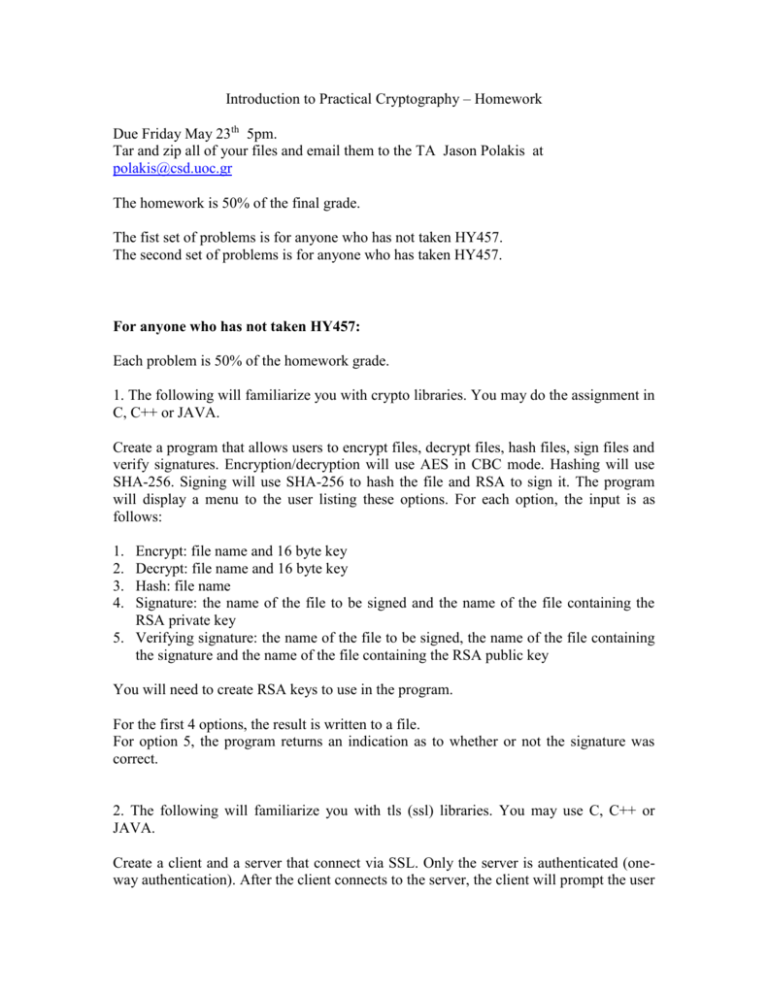
Introduction to Practical Cryptography – Homework Due Friday May 23th 5pm. Tar and zip all of your files and email them to the TA Jason Polakis at polakis@csd.uoc.gr The homework is 50% of the final grade. The fist set of problems is for anyone who has not taken HY457. The second set of problems is for anyone who has taken HY457. For anyone who has not taken HY457: Each problem is 50% of the homework grade. 1. The following will familiarize you with crypto libraries. You may do the assignment in C, C++ or JAVA. Create a program that allows users to encrypt files, decrypt files, hash files, sign files and verify signatures. Encryption/decryption will use AES in CBC mode. Hashing will use SHA-256. Signing will use SHA-256 to hash the file and RSA to sign it. The program will display a menu to the user listing these options. For each option, the input is as follows: 1. 2. 3. 4. Encrypt: file name and 16 byte key Decrypt: file name and 16 byte key Hash: file name Signature: the name of the file to be signed and the name of the file containing the RSA private key 5. Verifying signature: the name of the file to be signed, the name of the file containing the signature and the name of the file containing the RSA public key You will need to create RSA keys to use in the program. For the first 4 options, the result is written to a file. For option 5, the program returns an indication as to whether or not the signature was correct. 2. The following will familiarize you with tls (ssl) libraries. You may use C, C++ or JAVA. Create a client and a server that connect via SSL. Only the server is authenticated (oneway authentication). After the client connects to the server, the client will prompt the user for a single line of input and send it to the server. The server will receive the text from the client and print it to the screen. You may use self-signed certificates or may create a CA to sign the certificate (you do not need to get a certificate signed by a real CA). Useful starting points: JAVA: http://java.sun.com/j2se/1.5.0/docs/guide/security/jsse/JSSERefGuide.html http://java.sun.com/j2se/1.5.0/docs/api/javax/net/ssl/package-summary.html C: openssl library: 'man openssl' http://www.openssl.org/ For anyone who has taken HY457: Each problem is worth 1/3 of the homework grade. 1. Select one of the estream candidates from http://www.ecrypt.eu.org/stream/ that was not discussed in class (refer to the stream cipher lecture slides for the web site and candidates). Read the paper(s) on estream’s web site describing the candidate and summarize the algorithm. In addition to describing the key stream generation algorithm, include, as applicable, if the stream cipher is suited for software and/or hardware and why, how the internal state is updated, how the internal state is initialized, the length of the period, the length of the key, whether it is synchronous or asynchronous. 2. Timing of algorithms Use the AES code and Camellia code provided. You will need to modify it to record the time and run the necessary part(s). For each of AES and Camellia, you will find the average time it takes to encrypt a single block of data and the average time it takes to expand the key. Your answer will consist of AES encryption time: __ ms AES key expansion time: __ ms Camellia encryption time: __ ms Camellia key expansion time: __ ms Run the encryption function 1 million times (hard code a single plaintext and key, run the key expansion then loop through the encryption function 1 million times). What is the average time it takes to encrypt a single plaintext? Run the key expansion 1 million times (do not run the encryption function). What is the average time it takes to expand a key? 3. Simple statistical tests on AES The key will beheld constant through this experiment. Hard code a 128-bit key of all 0’s. Edit the AES code so you can specify how many rounds to run (all rounds will have all steps – you will be running AES for 1 to 4 rounds). For the number of rounds = 1,2,3,4 do the following: Encrypt 129 128-bit plaintexts, one that is all 0’s and every plaintext that has exactly one ‘1” in it in the following order: o Encrypt a plaintext of all 0’s o Encrypt every plaintext with exactly one ‘1”, starting with the least most significant bit set to one then moving the “1” one bit position until all 128 such plaintexts are encrypted. You will have 129 ciphertexts in all. Treat these as one continuous bit string, concatenated in the order in which they were generated. Find the following statistics for each of the four strings of ciphertexts generated (from 1,2,3 and 4 rounds). You will need to write a few programs to do this. 1. What percent of the ciphertext bits are 1’s? 2. How many runs of 1’s of length 2 are in the ciphertext? A run of length 2 is two consecutive 1’s followed by a 0 i.e. 0110001110110 has two such runs 3. How many runs of 0’s of length 2 are in the ciphertext? Do the answers change as the number of rounds increases from 1 to 4? If so how?
